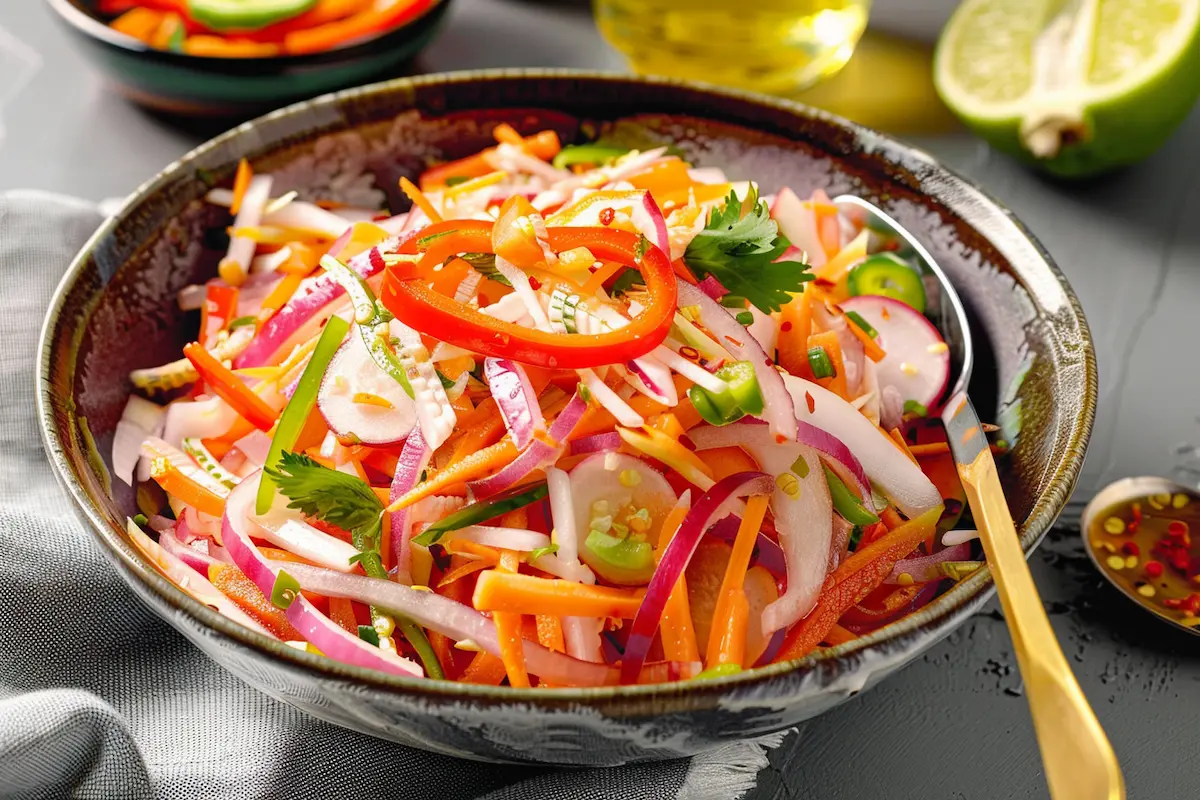Introduction
Curtido is a key component of Salvadoran cuisine, often considered the country’s version of sauerkraut or kimchi. This tangy, fermented cabbage slaw traditionally accompanies pupusas, a dish of corn tortillas filled with cheese, beans, or meat. However, curtido is more than just a condiment. With its rich history, versatility, and nutritional benefits, it combines freshness, acidity, and a delightful crunch that enhances many dishes.
In this article, we’ll explore the ingredients of curtido, how it’s prepared, its variations, and the cultural significance it holds. You’ll also discover how to make it at home and how it can be paired with different foods for maximum enjoyment.
The Basic Ingredients of Curtido
Curtido might appear simple, but its combination of vegetables, spices, and fermentation creates a unique, flavorful side dish. Below are the key ingredients found in traditional curtido:
1. Cabbage (Green Cabbage)
Cabbage, especially green cabbage, serves as the star ingredient in curtido. Shredded finely, it provides the bulk and crunch of the dish. Cabbage absorbs the vinegar and spices, softening slightly during fermentation while retaining its satisfying texture. It’s rich in fiber, vitamins C and K, and antioxidants.
Tip: Cabbage is an excellent fiber source. If you’re looking to incorporate more fiber into your diet, check out our Caesar Pasta Salad Recipe, which features fresh veggies for an added fiber boost.
2. Carrots
Carrots contribute both color and sweetness to the dish. Finely shredded, they blend well with the cabbage and enhance the dish’s appearance. Their sweetness balances the vinegar’s tang and adds an extra crunch.
Carrots are packed with beta-carotene, which the body converts into vitamin A to support healthy eyes and immune function.
3. Onions
Thinly sliced onions provide a pungent flavor that softens during fermentation. They add complexity to the overall taste, offering both sharpness and texture to the slaw.
In addition to their flavor, onions are a great source of sulfur compounds. These compounds help reduce inflammation and improve heart health.
4. Vinegar
The distinct tangy bite of curtido comes from vinegar, often white or apple cider vinegar. It not only enhances the flavor but also preserves the vegetables during the fermentation process. Vinegar promotes lactic acid fermentation, creating the sour taste and extending the shelf life of the dish.
Many health experts praise vinegar for its ability to support digestion and regulate blood sugar levels.
5. Oregano
Dried oregano adds an earthy flavor to curtido, balancing the acidity of the vinegar and enhancing the sweetness of the carrots. It’s a must-have ingredient in traditional curtido recipes.
Oregano also contains antioxidants and provides anti-inflammatory and antimicrobial benefits, making it both flavorful and health-boosting.
6. Red Pepper Flakes (Optional)
To add a subtle kick, many versions of curtido include red pepper flakes. While not always included, they bring heat to the dish, creating a spicy undertone that contrasts with the tanginess.
Red pepper flakes contain capsaicin, which is known for boosting metabolism and improving circulation.
7. Salt
Salt plays a critical role in the fermentation process. It draws out moisture from the vegetables, creating a brine that encourages lactic acid fermentation while preventing harmful bacteria from growing. This saltwater brine is essential for ensuring that the fermentation process occurs properly.
Without salt, the vegetables would spoil quickly, making it impossible to enjoy the benefits of fermentation.

How Curtido is Made: The Fermentation Process
Though you can enjoy curtido fresh, its traditional preparation involves a short fermentation period. Fermentation enhances the flavor and texture of curtido, turning it into a probiotic-rich food.
Lacto-Fermentation
Curtido undergoes lacto-fermentation, where naturally occurring bacteria convert sugars in the vegetables into lactic acid. This process not only preserves the vegetables but also gives them their distinctive tang and boosts the nutritional value.
To make curtido, combine the shredded cabbage, carrots, and onions with salt. This mixture releases moisture, which creates the brine. After adding vinegar and oregano, pack the vegetables into a jar, ensuring they’re submerged in liquid. Leave the mixture at room temperature for 2-5 days, depending on how tangy you prefer the flavor. Once fermented, curtido can be refrigerated and enjoyed for several weeks.
If you want to experiment with other fermented dishes, try our Pickle Pie Pizza Recipe, which adds a delicious tang to pizza.
Health Benefits of Curtido
Curtido isn’t just a flavorful side dish—it’s also rich in nutrients. The fermentation process increases the nutritional value of the vegetables, adds probiotics, and creates a healthy, delicious food.
1. Rich in Probiotics
Fermentation produces probiotics, which are beneficial bacteria that support digestive health. These probiotics help maintain a healthy gut by balancing the bacteria in your digestive system, improving nutrient absorption, and boosting your immune system.
A healthy gut microbiome has been linked to numerous health benefits, including better digestion, improved immune function, and even enhanced mental well-being. Incorporating probiotic-rich foods like curtido into your diet is a great way to support gut health.
2. High in Fiber
Cabbage, carrots, and onions provide a significant amount of fiber, which promotes digestive health and helps regulate blood sugar levels. Fiber is essential for supporting a healthy digestive system and maintaining a balanced diet.
High-fiber foods can also aid in weight management by promoting feelings of fullness, reducing the likelihood of overeating.
For another high-fiber dish, check out our Ultimate Guide to Baked Beans, a savory side that pairs beautifully with curtido.
3. Low in Calories
Curtido is naturally low in calories, making it a great addition to weight-conscious diets. A small serving adds flavor and texture without significantly increasing your caloric intake.
Because it’s low in fat and carbohydrates, curtido can be enjoyed by those following various dietary plans, including low-calorie and low-carb diets.
4. Antioxidant-Rich
The vegetables in curtido are rich in antioxidants, which help fight oxidative stress and lower the risk of chronic diseases. These antioxidants, combined with the anti-inflammatory properties of oregano, make curtido a health-promoting addition to any meal.
Adding antioxidant-rich foods like curtido to your diet may reduce the risk of heart disease, cancer, and diabetes.
Variations of Curtido
While the traditional recipe for curtido consists of cabbage, carrots, onions, and vinegar, you can create several variations based on personal preference. These variations add additional ingredients or spices to give the dish a unique twist.
1. Curtido with Beets
For a beautiful twist, some versions of curtido include beets, which give the dish a deep purple color and a slightly sweet flavor. Beets also add a boost of antioxidants and fiber, enhancing the nutritional value of the dish.
If you enjoy root vegetables, adding beets is a great way to make curtido even more nutritious.
2. Spicy Curtido
To satisfy spicy cravings, increase the amount of red pepper flakes or add fresh chilies. This variation brings more heat to the dish, creating a spicier version that complements richer meals like pupusas.
Spicy curtido pairs particularly well with grilled meats or tacos, adding heat to balance out heavier flavors.
Curtido in Salvadoran Cuisine
In Salvadoran cuisine, curtido is most famously served with pupusas, a traditional dish made of thick corn tortillas stuffed with cheese, beans, or meat. The tangy and crunchy curtido balances the rich, savory flavors of the pupusas, making them the perfect pairing.
Curtido’s versatility, however, extends beyond pupusas. It can also be served with tamales, tacos, grilled meats, and even sandwiches. Its fresh, tangy flavor enhances a variety of meals, making it a staple in Salvadoran households.
If you’re interested in more Salvadoran recipes that pair well with curtido, explore our Ultimate Guide to Making Delicious Flautas at Home, which offers crispy, flavorful recipes that benefit from a tangy slaw topping.
How to Make Curtido at Home
Curtido is surprisingly easy to make at home, requiring just a few ingredients and a bit of time for fermentation. Below is a simple recipe you can follow:
Basic Recipe for Curtido
Ingredients:
- 1 medium green cabbage, shredded
- 2 large carrots, shredded
- 1 small onion, thinly sliced
- 1 tablespoon dried oregano
- 1 teaspoon red pepper flakes (optional)
- 1/2 cup white vinegar or apple cider vinegar
- 1 tablespoon salt
- 2 cups water
Instructions:
- Combine the shredded cabbage, carrots, and onions in a large bowl.
- Sprinkle the salt over the vegetables, and massage them gently to release their juices. Let the mixture sit for about 10 minutes.
- Add the vinegar, oregano, and red pepper flakes, tossing everything together until well mixed.
- Pack the vegetable mixture tightly into a clean jar or container, making sure it’s fully submerged in its own juices. Add water if needed.
- Seal the jar and let it sit at room temperature for 3-5 days. Taste it daily to check how tangy it has become.
- Once it reaches your preferred tanginess, refrigerate the curtido. It will keep for several weeks.

Conclusion
Curtido is much more than a simple side dish. With its balance of tangy, crunchy vegetables, curtido complements various rich dishes and provides numerous health benefits. From boosting gut health with probiotics to offering antioxidants and fiber, this fermented slaw is a versatile, nutrient-rich addition to any meal.
Whether you’re serving it alongside pupusas or using it as a topping for sandwiches, tacos, or grilled meats, curtido is a refreshing, flavorful companion. Plus, with the easy-to-follow recipe provided, you can now enjoy this Salvadoran classic at home.
If you’re curious about more Salvadoran recipes or want to explore other fermented foods, check out our Curtido Recipe: A Traditional Salvadoran Slaw for additional tips and variations.

